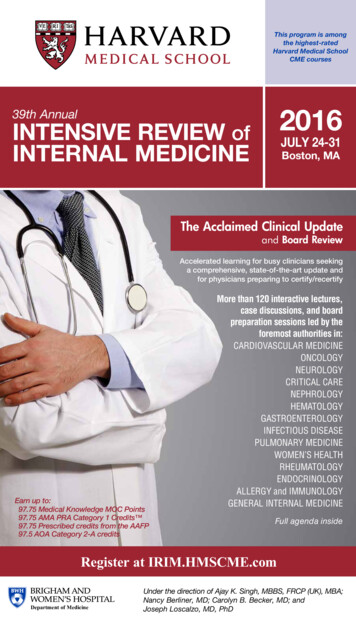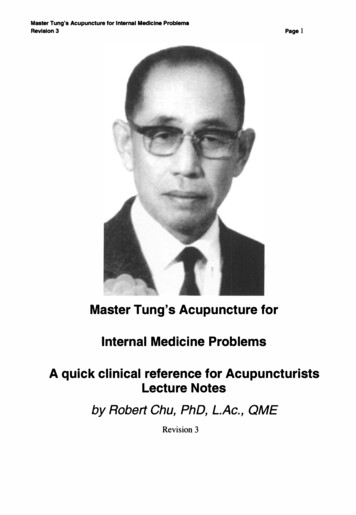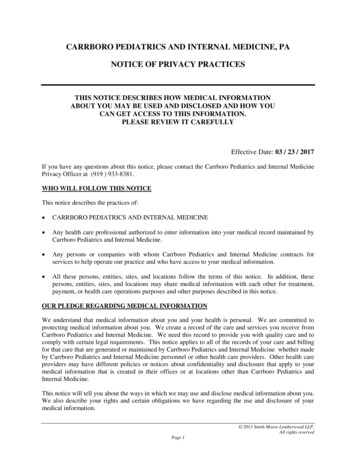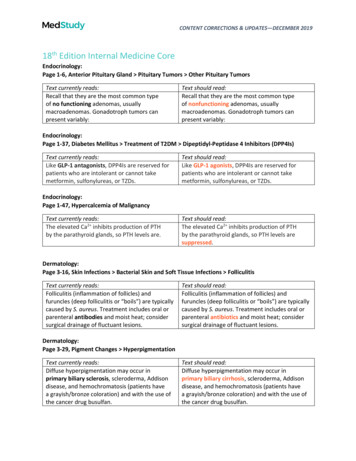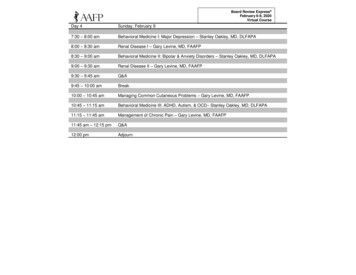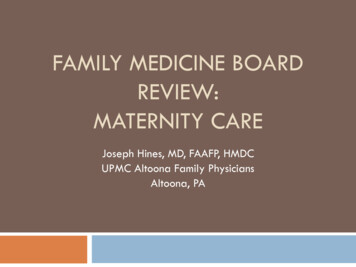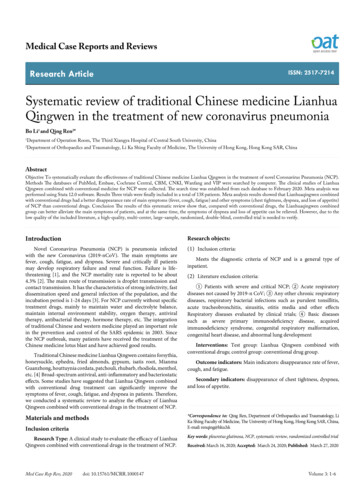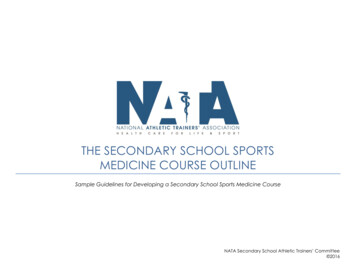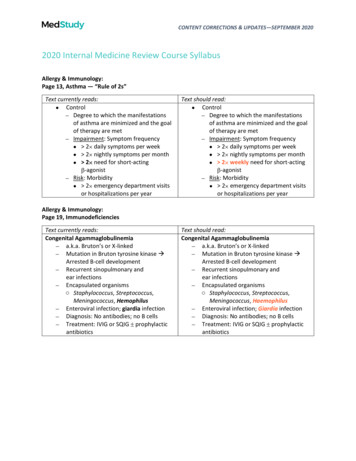
Transcription
CONTENT CORRECTIONS & UPDATES—SEPTEMBER 20202020 Internal Medicine Review Course SyllabusAllergy & Immunology:Page 13, Asthma — “Rule of 2s”Text currently reads: Control Degree to which the manifestationsof asthma are minimized and the goalof therapy are met Impairment: Symptom frequency 2 daily symptoms per week 2 nightly symptoms per month 2 need for short-actingβ-agonist Risk: Morbidity 2 emergency department visitsor hospitalizations per yearText should read: Control Degree to which the manifestationsof asthma are minimized and the goalof therapy are met Impairment: Symptom frequency 2 daily symptoms per week 2 nightly symptoms per month 2 weekly need for short-actingβ-agonist Risk: Morbidity 2 emergency department visitsor hospitalizations per yearAllergy & Immunology:Page 19, ImmunodeficienciesText currently reads:Congenital Agammaglobulinemia a.k.a. Bruton’s or X-linked Mutation in Bruton tyrosine kinase Arrested B-cell development Recurrent sinopulmonary andear infections Encapsulated organismso Staphylococcus, Streptococcus,Meningococcus, Hemophilus Enteroviral infection; giardia infection Diagnosis: No antibodies; no B cells Treatment: IVIG or SQIG prophylacticantibioticsText should read:Congenital Agammaglobulinemia a.k.a. Bruton’s or X-linked Mutation in Bruton tyrosine kinase Arrested B-cell development Recurrent sinopulmonary andear infections Encapsulated organismso Staphylococcus, Streptococcus,Meningococcus, Haemophilus Enteroviral infection; Giardia infection Diagnosis: No antibodies; no B cells Treatment: IVIG or SQIG prophylacticantibiotics
CONTENT CORRECTIONS & UPDATES—SEPTEMBER 2020Allergy & Immunology:Page 19, ImmunodeficienciesText currently reads:Common Variable Immunodeficiency Failure on B-cell maturation into plasmacells Recurrent sinopulmonary and earinfections Encapsulated organismso Staphylococcus, Streptococcus,Meningococcus, HemophilusBronchiectasis Enteroviral infection; giardia infection Increased risk of autoimmune diseaseand malignancy Diagnosis: low IgG with low IgA or lowIgM; low B cells Treatment: IVIG or SQIG prophylacticantibioticsText should read:Common Variable Immunodeficiency Failure on B-cell maturation into plasmacells Recurrent sinopulmonary and earinfections Encapsulated organismso Staphylococcus, Streptococcus,Meningococcus, HaemophilusBronchiectasis Enteroviral infection; Giardia infection Increased risk of autoimmune diseaseand malignancy Diagnosis: low IgG with low IgA or lowIgM; low B cells Treatment: IVIG or SQIG prophylacticantibioticsAllergy & Immunology:Page 20, Audience Response Answers and Explanatory Information — AR 4Text currently reads:Explanation: The correct answer is D.The patient most likely developed contactdermatitis from poison oak/ivy, consistentwith a Type 4 delayed hypersensitivity reaction.A. Type 1: Describes IgE-mediated reactions likeanaphylaxis.B. Type 2: Describes immunoglobulin- orantibody-mediated reactions likeidiopathic/immune thrombocytopenicpurpura.C. Type 3: Describes immune complex(antibody:antigen)-mediated disorders likeserum sickness.D. Type 4: Describes delayed cell-mediatedimmune reactions like contact dermatitis.Text should read:Explanation: The correct answer is D.The patient most likely developed contactdermatitis from poison oak/ivy, consistentwith a Type 4 delayed hypersensitivity reaction.A. Type 1: Describes IgE-mediated reactions likeanaphylaxis.B. Type 2: Describes immunoglobulin- orantibody-mediated reactions like immunethrombocytopenic purpura (ITP; formerlyidiopathic thrombocytopenic purpura).C. Type 3: Describes immune complex(antibody:antigen)-mediated disorders likeserum sickness.D. Type 4: Describes delayed cell-mediatedimmune reactions like contact dermatitis.
CONTENT CORRECTIONS & UPDATES—SEPTEMBER 2020Allergy & Immunology:Page 21, Audience Response Answers and Explanatory Information — AR 10Text currently reads:Explanation: The correct answer is C.This vignette describes a classic case of serumsickness.A. Type 1: Describes IgE-mediated reactionslike anaphylaxis.B. Type 2: Describes immunoglobulinor antibody-mediated reactions likeidiopathic/immune thrombocytopenicpurpura.C. Type 3: Describes immune complex(antibody:antigen)-mediated disorderslike serum sickness.D. Type 4: Describes cell-mediated immunereactions like celiac disease.Text should read:Explanation: The correct answer is C.This vignette describes a classic case of serumsickness.A. Type 1: Describes IgE-mediated reactionslike anaphylaxis.B. Type 2: Describes immunoglobulinor antibody-mediated reactions likeimmune thrombocytopenic purpura.C. Type 3: Describes immune complex(antibody:antigen)-mediated disorderslike serum sickness.D. Type 4: Describes cell-mediated immunereactions like celiac disease.Cardiology:Page 30, Hyperlipidemia In CAL the HIGH DR was MODERN!Text currently reads:* Continue statins persons 75 years of agewho have clinical ASCVD and are toleratingstatin therapy if HIGH intensity contraindicated/side effects,try moderate-intensity statin therapy% if 10-yr ASCVD risk 20 use HIGH-intensitystatin# Nonstatin Rx: 1st ezetimibe (10 mg) inhib. chol.intestinal absorb.; If LDL not lowered 50%,consider ezetimibe statin with long half-life1–3 times/wk; e.g., rosuvastatin 20 mg twice/wk2nd PCSK9 inhibitor (evolocumab, alirocumab)@ Also consider bile acid sequestrants(colesevelam, cholestyramine, colestipol)Text should read:* Continue statins persons 75 years of agewho have clinical ASCVD and are toleratingstatin therapy if HIGH intensity contraindicated/side effects,try moderate-intensity statin therapy% if 10-yr ASCVD risk 20 use HIGH-intensitystatin# Nonstatin Rx: 1st ezetimibe (10 mg) inhib. chol.intestinal absorb.; If LDL not lowered 50%,consider ezetimibe statin with long half-life1–3 times/wk; e.g., rosuvastatin 20 mg twice/wk2nd PCSK9 inhibitor (evolocumab, alirocumab).If elevated triglyceride levels despite statintherapy, and cardiovascular disease or diabetesand multiple other risk factors, add icosapentethyl (highly purified fish oil).@ Also consider bile acid sequestrants(colesevelam, cholestyramine, colestipol)
CONTENT CORRECTIONS & UPDATES—SEPTEMBER 2020Cardiology:Page 41, AR 14Text currently reads:A 51 yo man with MR is inactive and has a deskjob. He denies symptoms. He watches moviesand drinks beer on weekends.PE: BMI 32 kg/m2, BP 115/70 mmHg, pulse80 bpm.CVS: PMI diffuse 5th ICS midclavicular line andforceful, with a grade 4/6 systolic murmur heardloudest at apex, radiating to the axilla.CXR: Prominent LV ECG: NSR, LAE, borderline LVHTTE: Thickened myxomatous mitral valve, severemitral regurgitation; EF 45%; LV end-systolicdimension 4.8 cm.Text should read:A 51 yo man with MR is inactive and has a deskjob. He denies symptoms. He watches moviesand drinks beer on weekends.PE: BMI 32 kg/m2, BP 115/70 mmHg, pulse80 bpm.CVS: PMI diffuse 5th ICS midclavicular line andforceful, with a grade 4/6 systolic murmur heardloudest at apex, radiating to the axilla.CXR: Prominent LV; ECG: NSR, LAE,borderline LVHTTE: Thickened myxomatous mitral valve, severemitral regurgitation; EF 45%; LV end-systolicdimension 4.8 cm.Cardiology:Page 52, AR 19Text currently reads:A 59 yo Hispanic male patient had a largeanterior STEMI 1 year ago, LVEF 15%,s/p 3-V CABG. He is retired, paints, and doesother activities of daily living.Meds: Carvedilol, valsartan/sacubitril, aspirin,clopidogrel, furosemide, eplerenone, andatorvastatin. Physical: HR 70 bpm,BP 125/85 mmHg, R 16 breaths/minCVS: S1 S2 S3LUNGS: CTA Extremities: 1 mm pedal edema;ECG: NSR 70 bpm, old anterolateral MIEcho (1 month ago): LVEF 29%, anterolateralhypokinesis, moderately dilated left ventText should read:A 59 yo Hispanic male patient had a largeanterior STEMI 1 year ago, LVEF 15%,s/p 3-V CABG. He is retired, paints, and doesother activities of daily living.Meds: Carvedilol, valsartan/sacubitril, aspirin,clopidogrel, furosemide, eplerenone, andatorvastatin. Physical: HR 70 bpm,BP 125/85 mmHg, R 16 breaths/minCVS: S1 S2 S3LUNGS: CTA bilaterally;Extremities: 1 mm pedal edema;ECG: NSR 70 bpm, old anterolateral MIEcho (1 month ago): LVEF 29%, anterolateralhypokinesis, moderately dilated left vent
CONTENT CORRECTIONS & UPDATES—SEPTEMBER 2020Cardiology:Page 69, Left Axis DeviationECG currently shows:ECG should show:
CONTENT CORRECTIONS & UPDATES—SEPTEMBER 2020Cardiology:Page 69, Right Axis DeviationECG currently shows:ECG should show:
CONTENT CORRECTIONS & UPDATES—SEPTEMBER 2020Cardiology:Page 73, Wolff-Parkinson-White Pattern (Preexcitation)ECG currently shows:ECG should show:
CONTENT CORRECTIONS & UPDATES—SEPTEMBER 2020Dermatology:Page 7, Acne VulgarisText currently reads: Affects 85% of adolescents 12% of women continue to get lesionsthrough their 40s Predisposing factor ishyperresponsiveness to androgens(e.g., polycystic ovary syndrome) Main types: Comedonal (noninflammatory) Occlusion of follicles Inflammatory (papulopustular) Directed againstPropionibacterium acnes, excesssebum around hair follicle,follicular plugging Severe nodulocystic(know isotretinoin)Text should read: Affects 85% of adolescents 12% of women continue to get lesionsthrough their 40s Predisposing factor ishyperresponsiveness to androgens(e.g., polycystic ovary syndrome) Main types: Comedonal (noninflammatory) Occlusion of follicles Inflammatory (papulopustular) Directed againstPropionibacterium acnes, excesssebum around hair follicle,follicular plugging Severe nodulocystic(know isotretinoin)Dermatology:Page 13, Erythema Multiforme (EM)Text currently reads: 2 types1) EM minor No systemic symptoms No mucosal involvement2) EM major Systemic symptoms present Mucosal involvement severe Acute, target lesions pathognomonic Often self-limiting (muco) cutaneousdisorder Systemic steroids for severe mucosalinvolvement Infections HSV most common cayuse Often recurrent; May benefit fromsuppression Mycoplasma pneumoniae Treat active infection if wouldotherwise treat Drugs ( 10%) Sulfonamides, antiseizure medications,penicillins, NSAIDs, allopurinolText should read: 2 types1) EM minor No systemic symptoms No mucosal involvement2) EM major Systemic symptoms present Mucosal involvement severe Acute, target lesions pathognomonic Often self-limiting (muco) cutaneousdisorder Systemic steroids for severe mucosalinvolvement Infections HSV most common cayuse Often recurrent; May benefit fromsuppression Mycoplasma pneumoniae Only treat active infection Drugs ( 10%) Sulfonamides, antiseizure medications,penicillins, NSAIDs, allopurinol
CONTENT CORRECTIONS & UPDATES—SEPTEMBER 2020Endocrinology:Page 10, Cushing’s — Diagnostic WorkupText currently reads: Screen Confirm Localize Screen1) 24-hour urine free cortisol;Pitfall: Depression, alcoholism, false 2) 1-mg overnight dexamethasonesuppression test; Pitfall: Estrogenincreased CBG false 3) Late-night salivary cortisol;Pitfall: Shift workers? Confirm abnormal testText should read: Screen Confirm Localize Screen1) 24-hour urine free cortisol;Pitfall: Depression, alcoholism, false 2) 1-mg overnight dexamethasonesuppression test; Pitfall: Estrogenincreases CBG, false 3) Late-night salivary cortisol;Pitfall: Shift workers? Confirm abnormal testEndocrinology:Page 18, FibratesText currently reads: Decrease TG and raise HDL (small effecton LDL) Gemfibrozil is the only fibrate withdemonstrated CV benefit (Helsinki heart,VA-HIT) Was vs. placebo Fenofibrate, while more effective forreducing TG and less statin interaction,did not show benefit in RCTs (ACCORD)for 2 prevention Myopathy risk alone and especially whengemfibrozil statinsText should read: Decrease TG and raise HDL (small effecton LDL) Gemfibrozil is the only fibrate withdemonstrated CV benefit (Helsinki heart,VA-HIT) Gemfibrozil vs. placebo Fenofibrate, while more effective forreducing TG and less statin interaction,did not show benefit in RCTs (ACCORD)for 2 prevention Myopathy risk alone and especially whengemfibrozil statinsEndocrinology:Page 19, Diagnosis of Type 2 DMText currently reads: Random glucose 200 mg/dL withsymptoms of DM (polyuria, polydipsia,weight loss) Fasting plasma glucose 126 mg/dL 2 Glucose 200 mg/dL on 2-hour OGTT HbA1c 6.5% 2Text should read: Random glucose 200 mg/dL withsymptoms of DM (polyuria, polydipsia,weight loss, polyphagia) Fasting plasma glucose 126 mg/dL 2 Glucose 200 mg/dL on 2-hour OGTT HbA1c 6.5% 2
CONTENT CORRECTIONS & UPDATES—SEPTEMBER 2020Gastroenterology:Page 17, DiarrheaText currently reads: 200–250 g/day of stool, wherenormal is 150–180 g Normal stool frequency is 3/dayto 3/week General divisions Acute: 2 weeks Persistent: 2–4 weeks Chronic: 4 weeksText should read: 200–250 g/day of stool, wherenormal is 150–180 g/day Normal stool frequency is 3/dayto 3/week General divisions Acute: 2 weeks Persistent: 2–4 weeks Chronic: 4 weeksGeneral Internal Medicine:Page 5, Medications in OsteoporosisText currently reads: Glucocorticoids Antiseizure medications (phenobarbital,phenytoin, carbamazepine) Drugs associated with hypogonadism(depo medroxyprogesterone, GnRHs,aromatase inhibitors, methotrexate,chronic opioids) Thyroid over-replacement Cyclosporine LithiumText should read: Glucocorticoids Antiseizure medications (phenobarbital,phenytoin, carbamazepine) Drugs associated with hypogonadism(depot medroxyprogesterone, GnRHs,aromatase inhibitors, methotrexate,chronic opioids) Thyroid overreplacement Cyclosporine Lithium PPIGeneral Internal Medicine:Page 9, Testicular AbnormalitiesText currently reads: Painful mass: emergency! Torsion (testicular or testicularappendage) Epididymitis/Epididymoorchitis Hematocele Nonpainful: Hydrocele Varicocele Hernia Testicular cancer Skin cystsText should read: Painful mass: emergency! Torsion (testicular or testicularappendage) Epididymitis/Epididymoorchitis Hematocele Nonpainful mass: Hydrocele Varicocele Hernia Testicular cancer Skin cysts
CONTENT CORRECTIONS & UPDATES—SEPTEMBER 2020General Internal Medicine:Page 13, Perioperative Medicine — Management Heparin BridgingText currently reads: Diabetes agents Oral hypoglycemics —stop 24–72 hours before surgerydepending upon half-life of drugand risk of hypoglycemia No short acting the morningof surgery Basal insulin — continue same doseor reduce to 2/3Text should read: Diabetes agents Oral hypoglycemics —stop 24–72 hours before surgerydepending upon half-life of drugand risk of hypoglycemia No short-acting insulin the morningof surgery Basal insulin — continue same doseor reduce to 2/3General Internal Medicine:Page 14, Adult Immunization ScheduleTable currently reads:Young adultsAge11–26 and 26–45 (males too!)Every yearEvery 10 years 60ScheduleCompletion of childhood immunizations(MMR, Tdap or Td, polio, Hep A and B)HPV vaccineInfluenzaTdap once, then Td boosterRecombinant Zoster vaccine (2-dose seriesspaced 2–6 months apart)Table should read:Young adultsAge11–26 and 26–45 (males too!)Every yearEvery 10 years 50ScheduleCompletion of childhood immunizations(MMR, Tdap or Td, polio, Hep A and B)HPV vaccineInfluenzaTdap once, then Td boosterRecombinant Zoster vaccine (2-dose seriesspaced 2–6 months apart)
CONTENT CORRECTIONS & UPDATES—SEPTEMBER 2020General Internal Medicine:Page 17, Poisoning and Overdose AntidoteTable currently sIronMethanol, ysteineNaloxoneFlumazenil*Methylene blueDeferoxamineFomepizoleAtropine/Pralidoxime (2-PAM)Nitrates, sodium thiosulfate*Flumazenil not recommended for someone who is a chronic user of benzodiazepines, as it can induce seizureTable should IronMethanol, ysteineNaloxoneFlumazenil*Methylene blueDeferoxamineFomepizoleAtropine/Pralidoxime (2-PAM)Nitrites, sodium thiosulfate*Flumazenil not recommended for someone who is a chronic user of benzodiazepines, as it can induce seizureGeneral Internal Medicine:Page 19, Acute Sinusitis — TherapyText currently reads: Decongestants/Saline irrigation 1st line — amoxicillin/clavulanate (2 g bidin areas with 10% PRSP, 65 years ofage, hospitalization in last 5 days, severe,antibiotic use in previous month, multiplecomorbidities, immunocompromised) Alternative: doxycycline, levofloxacin,moxifloxacin 5- to 7-day duration of therapy TMP/SMX, macrolides, no longerrecommendedText should read: Decongestants/Saline irrigation 1st line — amoxicillin/clavulanate (2 g bidin areas with 10% PRSP, 65 years ofage, hospitalization in last 5 days, severe,antibiotic use in previous month, multiplecomorbidities, immunocompromised) Alternative: doxycycline, levofloxacin,moxifloxacin 5- to 7-day duration of therapy TMP/SMX or macrolides no longerrecommended
CONTENT CORRECTIONS & UPDATES—SEPTEMBER 2020General Internal Medicine:Page 19, Drugs to Absolutely Avoid During PregnancyText currently reads: Isotretinoin ACE inhibitors, ARBs, and spironolactone Benzodiazepines Quinolones and tetracyclines Tetracyclines Nitroprusside WarfarinText should read: Isotretinoin ACE inhibitors, ARBs, and spironolactone Benzodiazepines Quinolones and tetracyclines Tetracyclines Nitroprusside WarfarinGeneral Internal Medicine:Page 20, Preconception CareText currently reads: All women of childbearing age — 50%of pregnancies are unplanned! Folate (400 mg normally, 4 g high risk) Immunizations (TDaP, flu, VZV, MMR) Environmental toxins, domestic violence Review all meds and preexistingconditionsText should read: All women of childbearing age — 50%of pregnancies are unplanned! Folate (400 mg normally, 4 g high risk) Immunizations (Tdap, flu, varicella,MMR) Environmental toxins, domestic violence Review all meds and preexistingconditionsGeneral Internal Medicine:Page 21, SLE and PregnancyText currently reads: Normal fertility, but miscarriage rate1.5–3 increased Anti-Ro(SSA) or anti-La (SSB) antibodiesin the mother are associated withneonatal lupus and congenitalheart block If SLE active (especially with renalinvolvement) or if APLA or anti-dsDNA , increased riskof SLE flares and fetal problems Treat with steroids orhydroxychloroquine Avoid methotrexateText should read: Normal fertility, but miscarriage rate1.5–3 increased Anti-Ro(SSA) or anti-La (SSB) antibodiesin the mother are associated withneonatal lupus and congenitalheart block If SLE active (especially with renalinvolvement) or if APLA or antidsDNA , increased risk of SLE flaresand fetal problems Treat with steroids orhydroxychloroquine Avoid methotrexate
CONTENT CORRECTIONS & UPDATES—SEPTEMBER 2020Infectious Disease:Page 10, BabesiosisText currently reads: Clinical manifestations 1- to 4-week incubation period Asymptomatic ( 40%) Mild disease ( 4% parasitemia):fever, malaise, hemolysis,thrombocytopenia, transaminaseelevations, jaundice Severe disease ( 4% parasitemia):asplenic, immunocompromisedARDS, DIC, AKI, altered mental statusText should read: Clinical manifestations 1- to 4-week incubation period Asymptomatic ( 40%) Mild disease ( 4% parasitemia):fever, malaise, hemolysis,thrombocytopenia, transaminaseelevations, jaundice Severe disease ( 4% parasitemia):asplenic, immunocompromised,ARDS, DIC, AKI, altered mental statusInfectious Disease:Page 13, CoccidioidomycosisFigure currently reads:Figure should read (corrected spelling error):Infectious Disease:Page 39, Zika Virus 2020Text currently reads: Transmission Aedes mosquito-borne Flavivirus Dengue, Ebola, yellow feverText should read: Transmission Aedes mosquito-borne Flavivirusfamily Dengue, Ebola, yellow fever
CONTENT CORRECTIONS & UPDATES—SEPTEMBER 2020Infectious Disease:Page 49, This Patient’s Severity ScoresFigure currently reads:Figure should read (corrected spelling error):Nephrology:Page 8, Cryoglobulinemic GNText currently reads:PearlPurpuric rashRaynaud PhenomenonC4 is depressed, whereas C3 levels are lownormal. Renal disease may improve with Rx ofhepatitis C.Text should read:PearlPurpuric rashPseudo-Raynaud PhenomenonC4 is depressed, whereas C3 levels are lownormal. Renal disease may improve with Rx ofhepatitis C.Nephrology:Page 8, Nephritis with Normal Complements — ANCA Vasculitis and Anti-GBMText currently reads: Granulomatosis with polyangiitis(formerly Wegener’s) URTI (sinusitis, epistaxis) LRTI (infiltrates, cavitarylesions, DAH) C-ANCA anti-PR3Text should read: Granulomatosis with polyangiitis(formerly Wegener’s) URTI (sinusitis, epistaxis) LRTI (infiltrates, cavitary lesions,DAH, consolidation) C-ANCA anti-PR3
CONTENT CORRECTIONS & UPDATES—SEPTEMBER 2020Nephrology:Page 9, Focal Segmental Glomerulosclerosis — Clinical Clues and FeaturesText currently reads: Most common primary renal disease inAfrican Americans Patient usually hypertensive; Usuallyprogresses to ESRD over 5–20 years Primary (idiopathic) Secondary etiologies Familial — Gene mutations (APOI1) Drugs — Intravenous heroin,pamidronate Infections — HIV (collapsing FSGS)**,parvovirus Adaptive — Reflux nephropathy,obesityText should read: Most common primary renal disease inAfrican Americans Patient usually hypertensive; Usuallyprogresses to ESRD over 5–20 years Primary (idiopathic) Secondary etiologies Familial — Gene mutations (APOL1) Drugs — Intravenous heroin,pamidronate Infections — HIV (collapsing FSGS)**,parvovirus Adaptive — Reflux nephropathy,obesityNephrology:Page 12, Calcium and the Risk of Symptomatic Kidney Stones in MalesTable currently reads:Table should read (removed negative symbol; CI confidence interval, not chloride):
CONTENT CORRECTIONS & UPDATES—SEPTEMBER 2020Nephrology:Page 19, Approach to HyponatremiaText currently reads: Measure plasma osmolality Need toknow POsm When low, defines true hypoosmolal state or clinicalhyponatremia If high Plasma glucose; If normal Protein and lipidsText should read: Measure plasma osmolality Need toknow POsm When low, defines true hypoosmolarstate or clinical hyponatremia If high Plasma glucose; If normal Protein and lipidsNephrology:Page 22, Hyperkalemia Hyperkalemia — Inhibitors of the Renin-Angiotensin-Aldosterone SystemImage currently shows:Image should show potassium going out insteadof going in (see arrow):Neurology:Page 9, Stroke Ischemic Strokes Ischemic Stroke — ASA 2018 GuidelinesText currently reads: Systemic thrombolytics NIHSS 4Acute ischemic stroke 4.5 hours3–4.5 hours (exclude if 80 years ofage, DM, and prior ischemic stroke,anticoagulation, NIHSS 25)BP cannot be 185/110 mmHgNo tPA exclusion criteriaText should read: Systemic thrombolytics NIHSS 4Acute ischemic stroke 4.5 hours3–4.5 hours (exclude if 80 years ofage, DM, and prior ischemic stroke,anticoagulation, NIHSS 25)BP cannot be 185/110 mmHgNo absolute tPA exclusion criteria
CONTENT CORRECTIONS & UPDATES—SEPTEMBER 2020Pulmonary Medicine:Page 8, AR 6Text currently reads:A 47-year-old man is evaluated for worsening ofasthma symptoms characterized by frequentdaytime wheezing and cough, as well asnocturnal awakening related to asthma 2–3 timesper week.He has been using his inhalers regularly withoutadequate relief. He has not had recent URIinfection, sinusitis, postnasal drip, or newexposures. He is taking an inhaled corticosteroidand inhaled albuterol.On exam, temp 98.6 F, BP 135/80, HR 80, andRR 18. Lung exam reveals scattered bilateralwheezing. Spirometry shows an FEV1 of 70%of predicted. Following an inhaledbronchodilator, FEV1 improves to 90% ofpredicted.Text should read:A 47-year-old man is evaluated for worsening ofasthma symptoms characterized by frequentdaytime wheezing and cough, as well asnocturnal awakening related to asthma 2–3 timesper week.He has been using his inhalers regularly withoutadequate relief. He has not had recent URIinfection, sinusitis, postnasal drip, or newexposures. He is taking an inhaled corticosteroidand inhaled albuterol.On exam, temp 98.6 F (37 C), BP 135/80, HR 80,and RR 18. Lung exam reveals scattered bilateralwheezing. Spirometry shows an FEV1 of 70% ofpredicted. Following an inhaled bronchodilator,FEV1 improves to 90% of predicted.Pulmonary Medicine:Page 27, Exudative vs. TransudativeText currently reads: pH pH 7.0 suggests complicatedeffusion and possible need for chesttube or seen in RAText should read: pH pH 7.20 suggests complicatedeffusion and possible need for chesttube or seen in RARheumatology:Page 4, Joint Swelling vs. Bony EnlargementText currently reads: MCPs PIPIs Spongy/Boggy/ Painful DIPs spared Wrist swelling Inflammatory arthritis (like RA)Text should read: MCPs PIPIs Spongy/Boggy/Painful DIPs spared Wrist swelling Inflammatory arthritis (like RA)
CONTENT CORRECTIONS & UPDATES—SEPTEMBER 2020Rheumatology:Page 17, AR 7Text currently reads:22-year-old African American female witha 1-year h/o arthralgias, alopecia, fatigue withsun exposure, ANA, RNP. WBC 3.1. U/A notedRBC casts and 3 proteinuria.Text should read:22-year-old African American female witha 1-year h/o inflammatory arthritis, alopecia,fatigue with sun exposure, ANA, RNP. WBC 3.1.U/A noted RBC casts and 3 proteinuria.
2020 Internal Medicine Review Course Syllabus . Allergy & Immunology: Page 13, Asthma — “Rule of 2s” Text currently reads: Text should read: Control Degree to which the manifestations of asthma are minimized and the goal of therapy are met
